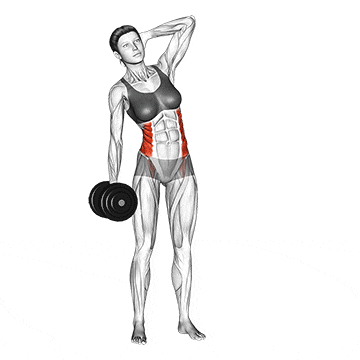The Standing Oblique Crunch is a bodyweight (or optionally weighted) exercise that resembles regular oblique crunches, but you do them standing up.
It primarily involves lateral flexion of the thoracic and lumbar spine in the frontal plane, bringing the rib cage closer to the pelvis on one side. This is often accompanied by a contralateral knee lift to meet the elbow.
Its primary purpose is to strengthen and sculpt the oblique muscles. The upright position reduces pressure on the lumbar spine and encourages better posture. Biomechanically, the exercise isolates the obliques and recruits deep core stabilizers.
There are different types of standing oblique crunches. So, I’ll show you the best ways to do standing side crunches for a shredded midsection.
- Standing oblique crunch
- Dumbbell standing crunch
- Standing cable oblique crunch

Standing Oblique Crunch Muscles Worked
- Primary Muscles: External Obliques and Internal Obliques
- Secondary Muscles: Rectus Abdominis (Abs), Hip Flexors (Iliopsoas) and Quadratus Lumborum
- Stabilizing Muscles: Transverse Abdominis, Erector Spinae, Gluteus Medius (for balance) and Adductors (to stabilize lower body)

How To Do a Standing Oblique Crunch
- Make sure you have a stable base by standing tall with your feet hip-width apart.
- Engage your core slightly by drawing your navel towards your spine and bracing.
- Place your hands lightly behind your head, fingers interlocked or just touching. Keep elbows wide. Avoid pulling on your neck.
- Maintain a proud chest and neutral spine.
- Exhale and simultaneously perform two actions: Lateral Flexion: Crunching your right side to bring your right elbow towards your right hip. Knee Lift: Lift your right knee up and slightly across your body towards your right elbow.
- The goal is to bring the elbow and knee as close as possible through oblique contraction and controlled hip flexion, not by rounding your shoulders forward or excessively twisting.
- Briefly pause at the point of maximum contraction, consciously squeezing your right obliques.
- Inhale. Slowly and with control, reverse the movement.
- Lower your right leg back to the starting position while simultaneously un-crunching your right side to return your torso to an upright, neutral position.
- Complete all desired repetitions on one side before switching to the other, or alternate sides.
Know More: 21 Best Oblique Exercises For A Strong Core
Tips and Form
- Perform each repetition with control. Avoid rushing; slow reps improve muscle activation and make each rep more effective.
- Keep your chest up and avoid arching your lower back. Your rib cage and pelvis should move toward each other, not away. This ensures the obliques are doing the work, not your lower back.
- If your hand is behind your head, use it only for light support-never pull on your neck. Keep your neck neutral and let your obliques drive the movement.
- Exhale during the effort phase (when bringing elbow and knee together) and inhale during the return. Never hold your breath; this can increase blood pressure and reduce stability.
- Keep your back straight, eyes facing forward, and bend at the torso only.
- Don’t start with heavy weights if you are doing a weighted standing side crunch. Start with lighter weights and work your way up.
- Take an adequate amount of rest between sets.
- Ultimately, your results will depend on your ability to recover from your workouts adequately.
Best Variations Of Standing Oblique Crunch
If you want a more advanced variation to stimulate different muscle fibers in the oblique, try the standing cable and dumbbell oblique crunch.
1. Standing Dumbbell Oblique Crunch
The standing dumbbell oblique crunch effectively targets the internal and external obliques, strengthens the lateral flexion of your spine, improves spinal mobility, and helps to develop a strong and stable core.
This is one of the best entry-level weighted oblique exercises I use for clients who are just starting resistance-based core training. When done with full range and control, it improves mind-muscle connection and gives a deep burn in the obliques.

2. Standing Cable Oblique Crunch
Adding the Standing Cable Oblique Crunch as a variation to your routine alongside the bodyweight Standing Oblique Crunch can be highly beneficial, especially when your goal is progressive overload, improved muscle tone, and advanced core engagement.
Cable resistance provides constant tension throughout the range of motion—something bodyweight alone can’t offer.
Cable resistance increases neuromuscular demand and encourages deeper core engagement, especially in the external obliques, internal obliques, and quadratus lumborum.

How To Do
- Attach the D-handle to a high pulley and stand side-on to the weight stack.
- Grasp the D-handle with your left hand and stand with the pulley to your left side.
- Ensure your forearm is positioned at a 90-degree angle to the upper arm and your feet are firmly placed on the floor at shoulder width.
- Keep your head up and back straight, and use your left oblique muscle to pull the weight down.
- Pause for a second and then return to the initial position.
- Do 10–12 reps.
- Turn around and repeat the cable side bend with your left side.

Manish is a NASM-certified fitness and nutrition coach with over 10 years of experience in weight lifting and fat loss fitness coaching. He specializes in gym-based training and has a lot of knowledge about exercise, lifting technique, biomechanics, and more.
Through “Fit Life Regime,” he generously shares the insights he’s gained over a decade in the field. His goal is to equip others with the knowledge to start their own fitness journey.
